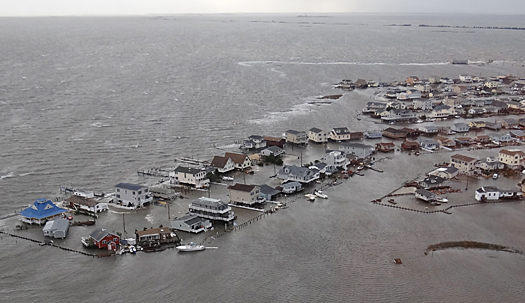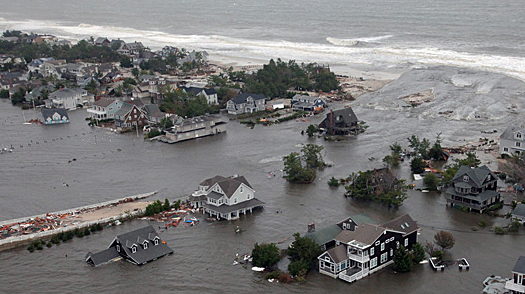Aftermath superstorm Sandy: How to reduce flood risk on US and Dutch barrier islands?
"Beach nourishment is a very cost effective way to protect barrier islands", says Dutch professor Pier Vellinga of the Wageningen University. "People enjoy living near the sea and settle on barrier islands like the ones along the New Jersey shore. Barrier islands are dynamic by nature, while people want to protect their fixed properties. It is inevitable we seek ways to fight beach erosion while simultaneously defend the fixed infrastructures and preserve the shoreline."
Vellinga reacts on the enormous havoc caused by superstorm Sandy on the coast of New Jersey when it made landfall on October 29.
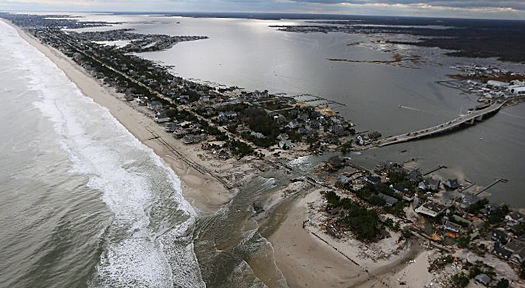
Flooding in Tuckerton (top photo) and a breach near Mantoloking (two above) after the storm surge caused by Sandy.
Breached barrier island
The historic high flooding destroyed many homes on the barrier islands along the 127 mile Jersey shore. The long stretched islands are so narrow that bay met ocean during the height of the storm, with water covering entire islands. In Mantoloking the small land strip was breached, leaving a bridge coming from the mainland to end up in the Atlantic Ocean.
Helping nature with extra sand suppletion
In the aftermath of Sandy the question raised whether Jersey shore will ever be the same. "In the Netherlands we have similar barrier islands in the Wadden Sea", continues professor Vellinga. "Studies have shown that it is possible to safe guard these islands by giving nature a helping hand and speed up the natural sand supply by beach nourishment."

Professor Pier Vellinga describes beach nourishment as an artificial river carrying loads of sediment to the seashores. The additional sediments heighten the beach and reduces the wave energy.
Fixed structures more expensive
"The problem is that people feel themselves better protected by more visible measures such as sea wall, groins and revetment. However, these fixed structures challenge, or should I say provoke, the sea. They reinforce the wave action, with additional erosion as a result. In the end they are usually more expensive than feeding the sea with sand when it is hungry. But for the public beach nourishment may look like carrying water to the sea. It is hard to find it back after a storm", as Vellinga explains why beach nourishment is not always so popular.
Preventive and reactive beach nourishment
Vellinga: "Beach nourishment in the USA is often practised after the match, repairing the beach in case of too much erosion. In the Netherland beach nourishment is now practised as a preventive measure. We feed the beach and foreshore well before erosion would brng the water too close to fixed properties. This way there is enough sand to prevent a breakthrough during an extreme event like Sandy."
Effective upscale dredging materials
"In the Netherlands there is an annual scheme of beach nourishment and dredging companies have invested in the development of effective upscaled dredging materials", according to Vellinga. "They are able to put the sand in place for 5 to 10 US dollar per cubic meter, and in large quantities even less than that."
Vellinga believes that US coasts will be better protected if the Jones Act is abandoned and beach nourishment projects are opened up to the competitive international dredging market.
Let nature do the work
He mentions the Sand Motor as an good example of cost effective flood risk reduction. Just off the Dutch coastline an artificial island has been created by the suppletion of 21,5 million cubic meter of sand. Wind, waves and currents will spread the sand naturally along the coast. The Sand Motor will gradually change in shape and will eventually be fully incorporated into the dunes and the beach. Vellinga: "Nature does all the work and that is much cheaper than to transporting the sand to the specific locations by ship".
(read more: North point of sand motor is already at work – October 11, 2011)
More flexible infrastructures
Like everywhere along sandy coastlines, the Jersey barrier islands are part of the dynamic coastal zone with sand constantly being moved by wind and tide. This makes its development with fixed structures a highly complex matter. In the Netherlands a group of scientists started the network organization Delta Alliance to raise more knowledge on the possibilities to increase the resilience of such vulnerable places. Vellinga is a member of this network: "One of the subjects we are studying at the moment, is to combine the beach nourishment with more flexible urban infrastructures".
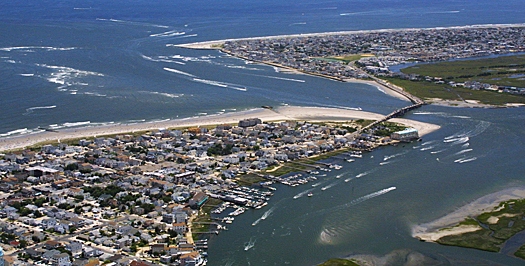
New Jersey coast: Townsends Inlet between the towns of Avalon (top) and Sea Isle (below), just south of Atlantic City. The towns are not protected by dunes.
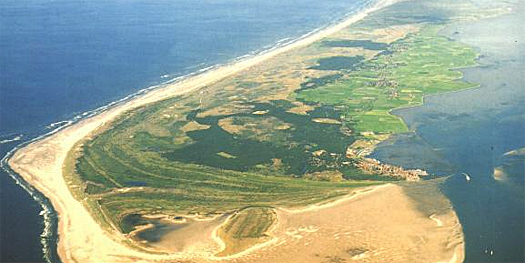
Dutch coast: barrier island Terschelling with the town of West-Terschelling (bottom right) that is protected from the sea (left) by dunes.
More flexible infrastructures
"In away the wooden houses and sea walls along the Jersey shore can be seen as such flexible infrastructures. They are easy to rebuild,” remarks Vellinga . “For the Wadden Sea we are studying the effects of sea level rise. It is clear that more beach nourishment will be needed for fixation of the barrier island as is currently the case. "
More flood prevention in US, more flood resilience in the Netherlands
Vellinga points out the differences between flood protection along the Jersey shore and the Wadden Sea. On the New Jersey barrier islands many houses are built directly next to the shoreline. The houses on the Wadden Sea barrier islands are built behind dunes.
"In the USA flood protection is based more on evacuation and flood insurance. People rebuilding their homes. In the Netherlands we have a high safety standard and are protected by dunes and dikes. However, in case of an extreme event a failure can be very lethal. I see two trends. In the USA there is more call for flood protection measures, like storm surge barriers. In the Netherlands we already build these structures and are now focusing on improving our flood resilience in case these fail."
Other news items on superstorm Sandy on this website:
● Adoption Dutch-based flood protection would require radical change US safety approach, 18 November 2012
● More new New Amsterdam: innovative flood protection for New York after superstorm Sandy, November 18, 2012
● NRP live radio debate: barricading New York against a rising sea, November 9, 2012
● Flood experts discuss need for storm surge barriers for coastal cities in aftermath of superstorm Sandy - November 2, 2012
● Dutch based flood protection plan for New York to revive in aftermath of superstorm Sandy - November 1, 2012
● Netherlands, US intensify cooperation on water management, climate resilience and flood preparedness, 5 March 2013
More information
Wageningen University & Research Centre
Professor Pier Vellinga
Programme director Climate Change
+31 317 486 665
www.climateresearchnetherlands.nl
Delta Alliance
Wim van Driel
Wageningen, the Netherlands
+31 317 482 308
www.delta-alliance.org
Sand Motor
Project office
zandmotor@kustvisiezuidholland.nl
www.dezandmotor.nl
Wadden Academy
Leeuwarden, the Netherlands
+31 58 233 90 30
www.waddenacademie.nl
A series of top events on flood risk reduction will take place in Rotterdam, the Netherlands from 19 till 23 November. Three international conferences will be held in conjunction:
- Room for the river conference, November 19
see full programme: www.ruimtevoorderivier.nl
- 2nd European Conference on Flood risk management, November 20-22
see full programme: www.floodrisk2012.net
- Delft-FEWS User Days, November 22-23
see full programme: www.delftsoftwaredays.nl




